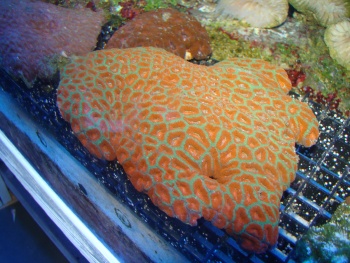
By Bob Goemans

Likely Reef Tank Suitable
Likely Fish-Only Tank Suitable
Range: Indo-West Pacific Ocean: Red Sea, Gulf of Aden, Hong Kong, Southern Japan, and south to Australia and Palau.
Natural Environment: Inhabits reef slopes and lagoons and seen at depths between 3 to 100 feet (1 - 30 m).
General Husbandry: Colorful specimens in the wild are uncommon and when available in the trade, now a cultured specimen.
Best maintained in medium to bright light, with moderate water movement, with mid-level placement in very brightly lit aquariums highly recommended.
Benefits from once or twice a week feedings of various plankton-like foods, such as Oyster eggs, cyclops, baby brine shrimp, Spirulina, enriched adult brine and mysis shrimp, and placed directly on the center of the polyps.
Feed only a small number of polyps, as food taken in will be shared by adjoining polyps.
Taxonomy:
Kingdom: Animalia
Phylum: Cnidaria
Class: Anthozoa
Subclass: Hexacorallia
Order: Scleractinia
Family: Mussidae
Genus: Micromussa
FYI: Cultured frags occasionally available.
Experience with this species has shown that if pH is maintained at 8.3, growth appears to accelerate.
Experience Level: Beginner
Diet: Photosynthetic/Plankton feeder
Temperament: Semi-aggressive
Aquarium Environment: Reef or fish-only aquarium
Coral Safe: With caution
Fish Safe: Yes
Invertebrate Safe: Yes
Acclimation Time: 30 minutes+
Aquarium Hardiness: Hardy
Calcium (Ca): 380 - 430 mg/l
Alkalinity: 2.5 - 3.0 meq/l
Phosphate (PO4): <0.05 mg/l
Magnesium (Mg): approx. 1350 mg/l (relate to specific gravity)
Strontium (Sr) 8 - 10 mg/l
Temperature Range: 74 - 83°F (23 - 28°C)
Minimum Tank Size: 50 gallons
Lighting: PAR 350 - 450+
Water Movement: WM 2 - 3
Specific Gravity: 1.023 - 1.025
pH: 8.0 - 8.4
Iodine/Trace Elements Monitor/as necessary to maintain quality seawater.
